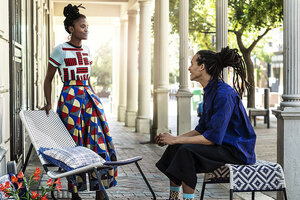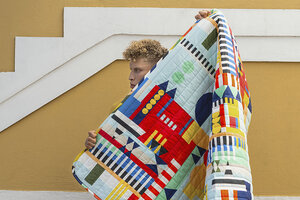In new Ikea line, African designers are more than ‘inspiration’

Senegalese designer Bibi Seck says this chair and footrest, which he created for the Overallt collection for IKEA, pay homage to the afternoons he spent as a child in his mother's garden in Dakar.
Daniel Wester/Courtesy of IKEA
Johannesburg
When Swedish do-it-yourself furniture giant Ikea announced this year that it was releasing a line of housewares in collaboration with 10 African designers, many approached the news with both excitement and skepticism.
On the one hand, the designers selected were some of the continent’s most celebrated: from Senegal’s Selly Raby Kane, best known in the West for outfitting Beyoncé in a funky kimono, to Ivorian architect and designer Issa Diabaté. And the idea that their designs would soon be on display inside angular Ikea showrooms around the world was, well, pretty cool.
On the other, there is a long history of Western brands taking African design ideas to add a bit of “exotic” flair to their collections. Think Louis Vuitton’s blue and red checked menswear collection of 2012, an obvious nod to the traditional clothing of the Maasai people of East Africa (which the company paired with khaki safariwear).
Why We Wrote This
Appreciation, or appropriation? Too often, artists and activists say, Western brands’ use of African designs is the latter. A new collection aims to get real collaboration right.
Sometimes, designers allege, it goes beyond inspiration from traditional motifs. The baguette bag that appeared in Yves Saint Laurent’s Paris Fashion Week show in 2017 was an echo, to many observers, of a bag released by a young Senegalese designer named Sarah Diouf under her label Tongoro the year before. Then there’s South African menswear creator Laduma Ngxokolo, who is participating in the Ikea project, known for work inspired by the bold geometry of Xhosa beadwork. When fast-fashion brand Zara produced diamond-patterned socks with a striking resemblance to one of his iconic designs last year, he sought legal action, and the brand quickly pulled socks from its shelves.
“Brands do this because they feel that they can get away with it,” says Nana Spio-Garbrah, the founder of Blueprint Africa, an interior design consultancy with offices in Ghana and Cote d’Ivoire. “And they know that often even if they have to pay damages in the end, they can afford it, so it won’t be a big deal.”
But from the start, to many of those involved, the Ikea project – called Överallt, or “everywhere” – felt different. For one thing, it was launched on the African continent, at an annual showcase for African design called Design Indaba, held each year in Cape Town. Design Indaba and Ikea hatched the idea together and collaborated to select designers and decide how the collection would look, says Design Indaba founder Ravi Naidoo.
“[We were asked], what could we add to Ikea? What would be a unique African perspective? What is there about our way of life that could add value to people living across the world?” he says.
One thing that quickly emerged was that the designers didn’t want to put out the “curio version” of Africa, says Sindiso Khumalo, a South African designer. With fellow designer and architect Renée Rossouw, she created textiles for the collection that were, in part, inspired by Johannesburg’s distinctive modernist architecture. “As a designer, I get this all the time: people saying ‘You can design a print for us,’ and then coming back to me and saying ‘Well, it isn’t African enough.’ This was different.”
Among the other items are a basket by Ms. Kane created to look like braided hair and a woven rocking chair that fellow Senegalese designer Bibi Seck created as an homage to days spent sitting in his mother’s garden in Dakar as a child.
Much of the collection is designed to evoke “a porousness between inside and outside,” says Mr. Naidoo of Design Indaba, a tribute to how much cultural life in many African countries takes place on porches, verandas, and other spaces poised between house and street. Issa Diabaté, for instance, designed a deceptively simple chair made from a single piece of plywood that can be used either inside or out.
But for African design fans, there’s at least one enduring disappointment about the collection: There are no Ikea stores anywhere on the continent, putting some of the most democratic versions of these often high-end designers’ work out of the reach of many of their most ardent fans.
“Many of us want to support this, but unless we’re already in London or Tokyo we won’t have the means to,” says Ms. Spio-Garbrah, the interior designer.
Ms. Khumalo too is disappointed about that, but she says she hopes that for the consumers her collection does reach, it will be meaningful.
“There’s so much fast fashion and fast furniture already out there,” she says. “We wanted to push back on that. We wanted to create pieces that could last and could even be passed on.”

